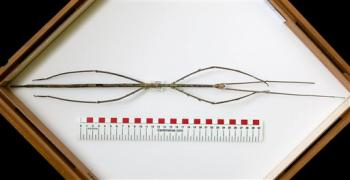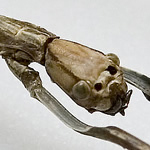What is the world’s longest insect?
mongabay.com
October 17, 2008
The Natural History Museum of London has revealed the world’s longest insect to be Phobaeticus chani, a stick insect from the rainforest of Sabah, a Malaysian state on the island of Borneo.
The longest specimen of the species, which is also known as Chan’s Megastick for its discoverer, Datuk Chan Chew Lun, measures 56.7 cm (22 inches) in length (including legs), about 1 cm longer than the prior title-holder, Phobaeticus serratipes from Indonesia and Malaysia. Its body length is 37.5 cm (14 inches), about 2.9 cm longer than the previous record-holder, Phobaeticus kirbyi, also from Borneo. Only three specimens of the species have been recorded, all from Sabah.
 Chan’s megastick (Phobaeticus chani). Courtesy of Britain’s Natural History Museum |
‘We’ve known about both of the previous record holders for over a hundred years, so it is extraordinary that an even bigger species has only just been discovered,’ said Dr George Beccaloni, stick-insect expert at London’s Natural History Museum.
While little is known about the new species — which is described in the current issue of the journal Zootaxa — it is believed to live in the rainforest canopy, making it vulnerable to the large-scale forest destruction that is occurring in Borneo due to logging the expansion of oil palm plantations.
  Datuk Chan Chew Lun and a close-up of the specimen’s head. Courtesy of Britain’s Natural History Museum |
‘It is a sad thought that many other spectacular insect species are disappearing as their habitats are destroyed, before we have even had the chance to find and name them,’ Beccaloni said.
Beyond its size, the species is also notable for its eggs, which have wing-like extensions that allow them to be wind-dispersed as the female drops them from the treetops.
There are some 3,000 known species of stick-insect, most of which are found in the topics and sub-tropics. Stick-insects are generally inactive during the day, remaining still and relying on their camouflage to disguise them from predators. Some species rely on chemical (noxious sprays) and physical (spines) defenses. noxious sprays or prickly spines to deter their predators